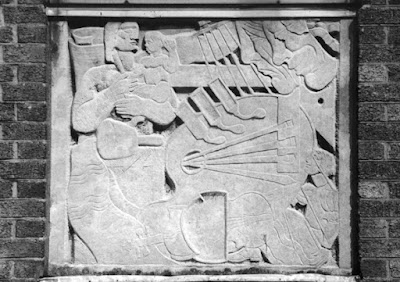 |
| At the Yorkshire Sculpture Park |
Continuing my investigation of the building stones of England and the development of my black and white photography, 1993 started with a contract to advise English Heritage on suitable stones to restore the Little Castle at Bolsover Castle in Derbyshire – where local Upper Carboniferous sandstone and Permian dolomitic sandstone had been used in its construction.
As part of the contract, I was also asked to report on Sutton Scarsdale Hall, which is built in a Pennine Middle Coal Measures Formation sandstone that has considerable colour variation and, in places, contains beds with ironstone nodules.
Although I used 35 mm colour prints for my report, I also took a couple of sets of photos on black and white film for my own use, as well as at the Old Bishop’s Palace in Lincoln too, which had been highlighted for restoration work.
1993 proved to be a year of great change, which ended up with me living in Lincoln and subsequently in Bakewell, in Derbyshire; however, although not a 'planned career move', I acquired as many examples of post-war architectural sculpture that I could find for the RCHME – a project that only lasted for a couple of years until their budget ran out, but which enabled me to finely hone my photographic skills.
At £10 per print, Lincoln probably wasn’t the best place to start, because it is set in a very large, predominantly rural county and I had to rely on A. Foster & Son in Horncastle, who provided a collection and delivery service, to do my processing and printing.
Nonetheless, I travelled widely in Lincolnshire, where I encountered various building stones that I had not known before – including the green Spilsby sandstone, Claxby ironstone, Lias limestone and Ancaster stone among others.
Most of the architectural sculptures that I encountered were made of materials other than stone, although the magnificent Portland stone sculpture entitled ‘Swimmers’ (1958) at Matthew Humberstone School in Weelsby, a suburb of Grimsby, was one of the notable exceptions.
Travelling further afield beyond the Humber Estuary and into Nottinghamshire, my knowledge of the regional geology further improved. At Rufford Abbey, in particular, there are good examples of White Mansfield stone and Red Mansfield stone and also the Scottish Locharbriggs sandstone, which has been used as a match for the latter.
My second spell of living in Lincoln didn’t last that long and I moved to Bakewell, where I had access to my own darkroom for the first time and my processing and printing skills progressed in leaps and bounds.
Bakewell and the surrounding Peak District National Park probably contains less post-war architectural sculptures than Lincolnshire and, although Derby and Sheffield are on its doorstep, I had to travel far and wide to accumulate enough photographs to make it worth the effort and cost.
When discussing possible further work with the RCHME, I was directed to the National Inventory of War Memorials and the PMSA and, although I was only paid by the Imperial War Museum to record a few memorials around the Forest of Bowland, it opened up my eyes to a wide variety of other sculptures in the public realm.
Searching further afield in West Yorkshire, the University of Leeds provided me with more excellent subject material, in various materials, and my favourite has to be the sculpture entitled Man-Made Fibres, by Mitzi Cunliffe (1956), which adorns Clothworkers’ Building South.
By the end of 1994, work for the RCHME had dried up but, having discovered the Yorkshire Sculpture Park, I continued to find plenty of subject material for the further development of my darkroom skills; however, by this time I had started to write for various trade and professional journals, where colour transparencies were the preferred medium.
One of these articles reported on the Museum of Sculpted Stone in the small town of Fanano, in the Emilia Romagna region of Italy, a place that I have visited a few times to see friends. Over 250 pieces of sculpture, left behind after the international sculpture symposiums, decorate the town and, during one visit that coincided with a symposium, I won first prize in a photographic competition that was held during the event.
 |
| "Tristezza" |






















































